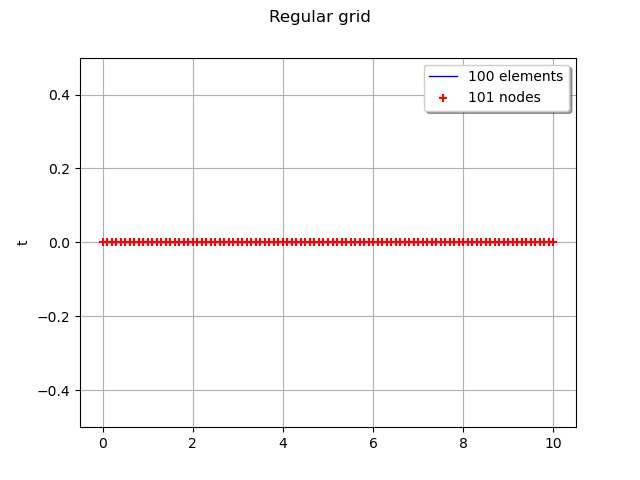The main goal of this example is to briefly review the most important covariance models and compare them in terms of regularity.
We first show how to define a covariance model, a temporal grid and a Gaussian process.
We first consider the squared exponential covariance model and show how the trajectories are sensitive to its parameters.
We show how to define a trend. In the final section, we compare the trajectories from exponential and Matérn covariance models.
Gaussian processes
In order to create a GaussianProcess, we must have:
a covariance model,
a grid.
Optionnally, we can define a trend (we will see that later in the example). By default, the trend is zero.
We consider the domain ![\mathcal{D}=[0,10]](data:image/svg+xml;base64,PD94bWwgdmVyc2lvbj0nMS4wJyBlbmNvZGluZz0nVVRGLTgnPz4KPCEtLSBUaGlzIGZpbGUgd2FzIGdlbmVyYXRlZCBieSBkdmlzdmdtIDMuNC4yIC0tPgo8c3ZnIHZlcnNpb249JzEuMScgeG1sbnM9J2h0dHA6Ly93d3cudzMub3JnLzIwMDAvc3ZnJyB4bWxuczp4bGluaz0naHR0cDovL3d3dy53My5vcmcvMTk5OS94bGluaycgd2lkdGg9JzU0LjYwNjk5MXB0JyBoZWlnaHQ9JzExLjk1NTE2OHB0JyB2aWV3Qm94PScwIC04Ljk2NjM3NiA1NC42MDY5OTEgMTEuOTU1MTY4Jz4KPGRlZnM+CjxwYXRoIGlkPSdnMS01OScgZD0nTTIuMzMxMjU4IC4wNDc4MjFDMi4zMzEyNTgtLjY0NTU3OSAyLjEwNDExLTEuMTU5NjUxIDEuNjEzOTQ4LTEuMTU5NjUxQzEuMjMxMzgyLTEuMTU5NjUxIDEuMDQwMS0uODQ4ODE3IDEuMDQwMS0uNTg1ODAzUzEuMjE5NDI3IDAgMS42MjU5MDMgMEMxLjc4MTMyIDAgMS45MTI4MjctLjA0NzgyMSAyLjAyMDQyMy0uMTU1NDE3QzIuMDQ0MzM0LS4xNzkzMjggMi4wNTYyODktLjE3OTMyOCAyLjA2ODI0NC0uMTc5MzI4QzIuMDkyMTU0LS4xNzkzMjggMi4wOTIxNTQtLjAxMTk1NSAyLjA5MjE1NCAuMDQ3ODIxQzIuMDkyMTU0IC40NDIzNDEgMi4wMjA0MjMgMS4yMTk0MjcgMS4zMjcwMjQgMS45OTY1MTNDMS4xOTU1MTcgMi4xMzk5NzUgMS4xOTU1MTcgMi4xNjM4ODUgMS4xOTU1MTcgMi4xODc3OTZDMS4xOTU1MTcgMi4yNDc1NzIgMS4yNTUyOTMgMi4zMDczNDcgMS4zMTUwNjggMi4zMDczNDdDMS40MTA3MSAyLjMwNzM0NyAyLjMzMTI1OCAxLjQyMjY2NSAyLjMzMTI1OCAuMDQ3ODIxWicvPgo8cGF0aCBpZD0nZzItNDgnIGQ9J001LjM1NTkxNS0zLjgyNTY1NEM1LjM1NTkxNS00LjgxNzkzMyA1LjI5NjEzOS01Ljc4NjMwMSA0Ljg2NTc1My02LjY5NDg5NEM0LjM3NTU5Mi03LjY4NzE3MyAzLjUxNDgxOS03Ljk1MDE4NyAyLjkyOTAxNi03Ljk1MDE4N0MyLjIzNTYxNi03Ljk1MDE4NyAxLjM4NjgtNy42MDM0ODcgLjk0NDQ1OC02LjYxMTIwOEMuNjA5NzE0LTUuODU4MDMyIC40OTAxNjItNS4xMTY4MTIgLjQ5MDE2Mi0zLjgyNTY1NEMuNDkwMTYyLTIuNjY2MDAyIC41NzM4NDgtMS43OTMyNzUgMS4wMDQyMzQtLjk0NDQ1OEMxLjQ3MDQ4Ni0uMDM1ODY2IDIuMjk1MzkyIC4yNTEwNTkgMi45MTcwNjEgLjI1MTA1OUMzLjk1NzE2MSAuMjUxMDU5IDQuNTU0OTE5LS4zNzA2MSA0LjkwMTYxOS0xLjA2NDAxQzUuMzMyMDA1LTEuOTYwNjQ4IDUuMzU1OTE1LTMuMTMyMjU0IDUuMzU1OTE1LTMuODI1NjU0Wk0yLjkxNzA2MSAuMDExOTU1QzIuNTM0NDk2IC4wMTE5NTUgMS43NTc0MS0uMjAzMjM4IDEuNTMwMjYyLTEuNTA2MzUxQzEuMzk4NzU1LTIuMjIzNjYxIDEuMzk4NzU1LTMuMTMyMjU0IDEuMzk4NzU1LTMuOTY5MTE2QzEuMzk4NzU1LTQuOTQ5NDQgMS4zOTg3NTUtNS44MzQxMjIgMS41OTAwMzctNi41Mzk0NzdDMS43OTMyNzUtNy4zNDA0NzMgMi40MDI5ODktNy43MTEwODMgMi45MTcwNjEtNy43MTEwODNDMy4zNzEzNTctNy43MTEwODMgNC4wNjQ3NTctNy40MzYxMTUgNC4yOTE5MDUtNi40MDc5N0M0LjQ0NzMyMy01LjcyNjUyNiA0LjQ0NzMyMy00Ljc4MjA2NyA0LjQ0NzMyMy0zLjk2OTExNkM0LjQ0NzMyMy0zLjE2ODEyIDQuNDQ3MzIzLTIuMjU5NTI3IDQuMzE1ODE2LTEuNTMwMjYyQzQuMDg4NjY3LS4yMTUxOTMgMy4zMzU0OTIgLjAxMTk1NSAyLjkxNzA2MSAuMDExOTU1WicvPgo8cGF0aCBpZD0nZzItNDknIGQ9J00zLjQ0MzA4OC03LjY2MzI2M0MzLjQ0MzA4OC03LjkzODIzMiAzLjQ0MzA4OC03Ljk1MDE4NyAzLjIwMzk4NS03Ljk1MDE4N0MyLjkxNzA2MS03LjYyNzM5NyAyLjMxOTMwMy03LjE4NTA1NiAxLjA4NzkyLTcuMTg1MDU2Vi02LjgzODM1NkMxLjM2Mjg4OS02LjgzODM1NiAxLjk2MDY0OC02LjgzODM1NiAyLjYxODE4Mi03LjE0OTE5MVYtLjkyMDU0OEMyLjYxODE4Mi0uNDkwMTYyIDIuNTgyMzE2LS4zNDY3IDEuNTMwMjYyLS4zNDY3SDEuMTU5NjUxVjBDMS40ODI0NDEtLjAyMzkxIDIuNjQyMDkyLS4wMjM5MSAzLjAzNjYxMy0uMDIzOTFTNC41Nzg4MjktLjAyMzkxIDQuOTAxNjE5IDBWLS4zNDY3SDQuNTMxMDA5QzMuNDc4OTU0LS4zNDY3IDMuNDQzMDg4LS40OTAxNjIgMy40NDMwODgtLjkyMDU0OFYtNy42NjMyNjNaJy8+CjxwYXRoIGlkPSdnMi02MScgZD0nTTguMDY5NzM4LTMuODczNDc0QzguMjM3MTExLTMuODczNDc0IDguNDUyMzA0LTMuODczNDc0IDguNDUyMzA0LTQuMDg4NjY3QzguNDUyMzA0LTQuMzE1ODE2IDguMjQ5MDY2LTQuMzE1ODE2IDguMDY5NzM4LTQuMzE1ODE2SDEuMDI4MTQ0Qy44NjA3NzItNC4zMTU4MTYgLjY0NTU3OS00LjMxNTgxNiAuNjQ1NTc5LTQuMTAwNjIzQy42NDU1NzktMy44NzM0NzQgLjg0ODgxNy0zLjg3MzQ3NCAxLjAyODE0NC0zLjg3MzQ3NEg4LjA2OTczOFpNOC4wNjk3MzgtMS42NDk4MTNDOC4yMzcxMTEtMS42NDk4MTMgOC40NTIzMDQtMS42NDk4MTMgOC40NTIzMDQtMS44NjUwMDZDOC40NTIzMDQtMi4wOTIxNTQgOC4yNDkwNjYtMi4wOTIxNTQgOC4wNjk3MzgtMi4wOTIxNTRIMS4wMjgxNDRDLjg2MDc3Mi0yLjA5MjE1NCAuNjQ1NTc5LTIuMDkyMTU0IC42NDU1NzktMS44NzY5NjFDLjY0NTU3OS0xLjY0OTgxMyAuODQ4ODE3LTEuNjQ5ODEzIDEuMDI4MTQ0LTEuNjQ5ODEzSDguMDY5NzM4WicvPgo8cGF0aCBpZD0nZzItOTEnIGQ9J00yLjk4ODc5MiAyLjk4ODc5MlYyLjU0NjQ1MUgxLjgyOTE0MVYtOC41MjQwMzVIMi45ODg3OTJWLTguOTY2Mzc2SDEuMzg2OFYyLjk4ODc5MkgyLjk4ODc5MlonLz4KPHBhdGggaWQ9J2cyLTkzJyBkPSdNMS44NTMwNTEtOC45NjYzNzZILjI1MTA1OVYtOC41MjQwMzVIMS40MTA3MVYyLjU0NjQ1MUguMjUxMDU5VjIuOTg4NzkySDEuODUzMDUxVi04Ljk2NjM3NlonLz4KPHBhdGggaWQ9J2cwLTY4JyBkPSdNMi40Mzg4NTQgMEM1LjIyNDQwOCAwIDkuMTU3NjU5LTIuMTI4MDIgOS4xNTc2NTktNS4zOTE3ODFDOS4xNTc2NTktNi40NTU3OTEgOC42NTU1NDItNy4xMjUyOCA4LjA2OTczOC03LjQ5NTg5QzcuMDQxNTk0LTguMTY1MzggNS45NDE3MTktOC4xNjUzOCA0LjgwNTk3OC04LjE2NTM4QzMuNzc3ODMzLTguMTY1MzggMy4wNzI0NzgtOC4xNjUzOCAyLjA2ODI0NC03LjczNDk5NEMuNDc4MjA3LTcuMDI5NjM5IC4yNTEwNTktNi4wMzczNiAuMjUxMDU5LTUuOTQxNzE5Qy4yNTEwNTktNS44Njk5ODggLjI5ODg3OS01Ljg0NjA3NyAuMzcwNjEtNS44NDYwNzdDLjU2MTg5My01Ljg0NjA3NyAuODM2ODYyLTYuMDEzNDUgLjkzMjUwMy02LjA3MzIyNUMxLjE4MzU2Mi02LjI0MDU5OCAxLjIxOTQyNy02LjMxMjMyOSAxLjI5MTE1OC02LjUzOTQ3N0MxLjQ1ODUzMS03LjAxNzY4NCAxLjc5MzI3NS03LjQzNjExNSAzLjI5OTYyNi03LjUwNzg0NkMzLjEwODM0NC01LjAwOTIxNSAyLjQ5ODYzLTIuNzI1Nzc4IDEuNjYxNzY4LS42MzM2MjRDMS4yMTk0MjctLjQ3ODIwNyAuOTMyNTAzLS4yMDMyMzggLjkzMjUwMy0uMDgzNjg2Qy45MzI1MDMtLjAxMTk1NSAuOTQ0NDU4IDAgMS4yMDc0NzIgMEgyLjQzODg1NFpNMi40OTg2My0uNjU3NTM0QzMuODYxNTE5LTMuOTkzMDI2IDQuMTEyNTc4LTYuMDczMjI1IDQuMjc5OTUtNy41MDc4NDZDNS4wODA5NDYtNy41MDc4NDYgOC4xNDE0NjktNy41MDc4NDYgOC4xNDE0NjktNC44Nzc3MDlDOC4xNDE0NjktMi41MzQ0OTYgNi4wMzczNi0uNjU3NTM0IDMuMTQ0MjA5LS42NTc1MzRIMi40OTg2M1onLz4KPC9kZWZzPgo8ZyBpZD0ncGFnZTEnPgo8dXNlIHg9JzAnIHk9JzAnIHhsaW5rOmhyZWY9JyNnMC02OCcvPgo8dXNlIHg9JzEyLjg3NTA1OCcgeT0nMCcgeGxpbms6aHJlZj0nI2cyLTYxJy8+Cjx1c2UgeD0nMjUuMzAwNTM5JyB5PScwJyB4bGluazpocmVmPScjZzItOTEnLz4KPHVzZSB4PScyOC41NTIyJyB5PScwJyB4bGluazpocmVmPScjZzItNDgnLz4KPHVzZSB4PSczNC40MDUxOTEnIHk9JzAnIHhsaW5rOmhyZWY9JyNnMS01OScvPgo8dXNlIHg9JzM5LjY0OTM1JyB5PScwJyB4bGluazpocmVmPScjZzItNDknLz4KPHVzZSB4PSc0NS41MDIzNCcgeT0nMCcgeGxpbms6aHJlZj0nI2cyLTQ4Jy8+Cjx1c2UgeD0nNTEuMzU1MzMnIHk9JzAnIHhsaW5rOmhyZWY9JyNnMi05MycvPgo8L2c+Cjwvc3ZnPgo8IS0tIERFUFRIPTQgLS0+) . We discretize this domain with 100 cells (which corresponds to 101 nodes), with steps equal to 0.1 starting from 0:
. We discretize this domain with 100 cells (which corresponds to 101 nodes), with steps equal to 0.1 starting from 0:
xmin = 0.0
step = 0.1
n = 100
myTimeGrid = ot.RegularGrid(xmin, step, n + 1)
graph = myTimeGrid.draw()
graph.setTitle("Regular grid")
view = viewer.View(graph)

Then we create the Gaussian process (by default the trend is zero).
process = ot.GaussianProcess(myModel, myTimeGrid)
process
class=GaussianProcess mesh=class=Mesh name=Unnamed dimension=1 vertices=class=Sample name=Unnamed implementation=class=SampleImplementation name=Unnamed size=101 dimension=1 description=[t] data=[[0],[0.1],[0.2],[0.3],[0.4],[0.5],[0.6],[0.7],[0.8],[0.9],[1],[1.1],[1.2],[1.3],[1.4],[1.5],[1.6],[1.7],[1.8],[1.9],[2],[2.1],[2.2],[2.3],[2.4],[2.5],[2.6],[2.7],[2.8],[2.9],[3],[3.1],[3.2],[3.3],[3.4],[3.5],[3.6],[3.7],[3.8],[3.9],[4],[4.1],[4.2],[4.3],[4.4],[4.5],[4.6],[4.7],[4.8],[4.9],[5],[5.1],[5.2],[5.3],[5.4],[5.5],[5.6],[5.7],[5.8],[5.9],[6],[6.1],[6.2],[6.3],[6.4],[6.5],[6.6],[6.7],[6.8],[6.9],[7],[7.1],[7.2],[7.3],[7.4],[7.5],[7.6],[7.7],[7.8],[7.9],[8],[8.1],[8.2],[8.3],[8.4],[8.5],[8.6],[8.7],[8.8],[8.9],[9],[9.1],[9.2],[9.3],[9.4],[9.5],[9.6],[9.7],[9.8],[9.9],[10]] simplices=[[0,1],[1,2],[2,3],[3,4],[4,5],[5,6],[6,7],[7,8],[8,9],[9,10],[10,11],[11,12],[12,13],[13,14],[14,15],[15,16],[16,17],[17,18],[18,19],[19,20],[20,21],[21,22],[22,23],[23,24],[24,25],[25,26],[26,27],[27,28],[28,29],[29,30],[30,31],[31,32],[32,33],[33,34],[34,35],[35,36],[36,37],[37,38],[38,39],[39,40],[40,41],[41,42],[42,43],[43,44],[44,45],[45,46],[46,47],[47,48],[48,49],[49,50],[50,51],[51,52],[52,53],[53,54],[54,55],[55,56],[56,57],[57,58],[58,59],[59,60],[60,61],[61,62],[62,63],[63,64],[64,65],[65,66],[66,67],[67,68],[68,69],[69,70],[70,71],[71,72],[72,73],[73,74],[74,75],[75,76],[76,77],[77,78],[78,79],[79,80],[80,81],[81,82],[82,83],[83,84],[84,85],[85,86],[86,87],[87,88],[88,89],[89,90],[90,91],[91,92],[92,93],[93,94],[94,95],[95,96],[96,97],[97,98],[98,99],[99,100]] trend=class=TrendTransform inherited from class=VertexValueFunction evaluation=class=Function name=Unnamed implementation=class=FunctionImplementation name=Unnamed description=[x0,x0,y0] evaluationImplementation=class=TrendEvaluation name=Unnamed function=class=Function name=Unnamed implementation=class=FunctionImplementation name=Unnamed description=[x0,y0] evaluationImplementation=class=SymbolicEvaluation name=Unnamed inputVariablesNames=[x0] outputVariablesNames=[y0] formulas=[0.0] gradientImplementation=class=SymbolicGradient name=Unnamed evaluation=class=SymbolicEvaluation name=Unnamed inputVariablesNames=[x0] outputVariablesNames=[y0] formulas=[0.0] hessianImplementation=class=SymbolicHessian name=Unnamed evaluation=class=SymbolicEvaluation name=Unnamed inputVariablesNames=[x0] outputVariablesNames=[y0] formulas=[0.0] gradientImplementation=class=CenteredFiniteDifferenceGradient name=Unnamed epsilon=class=Point name=Unnamed dimension=2 values=[1e-05,1e-05] evaluation=class=TrendEvaluation name=Unnamed function=class=Function name=Unnamed implementation=class=FunctionImplementation name=Unnamed description=[x0,y0] evaluationImplementation=class=SymbolicEvaluation name=Unnamed inputVariablesNames=[x0] outputVariablesNames=[y0] formulas=[0.0] gradientImplementation=class=SymbolicGradient name=Unnamed evaluation=class=SymbolicEvaluation name=Unnamed inputVariablesNames=[x0] outputVariablesNames=[y0] formulas=[0.0] hessianImplementation=class=SymbolicHessian name=Unnamed evaluation=class=SymbolicEvaluation name=Unnamed inputVariablesNames=[x0] outputVariablesNames=[y0] formulas=[0.0] hessianImplementation=class=CenteredFiniteDifferenceHessian name=Unnamed epsilon=class=Point name=Unnamed dimension=2 values=[0.0001,0.0001] evaluation=class=TrendEvaluation name=Unnamed function=class=Function name=Unnamed implementation=class=FunctionImplementation name=Unnamed description=[x0,y0] evaluationImplementation=class=SymbolicEvaluation name=Unnamed inputVariablesNames=[x0] outputVariablesNames=[y0] formulas=[0.0] gradientImplementation=class=SymbolicGradient name=Unnamed evaluation=class=SymbolicEvaluation name=Unnamed inputVariablesNames=[x0] outputVariablesNames=[y0] formulas=[0.0] hessianImplementation=class=SymbolicHessian name=Unnamed evaluation=class=SymbolicEvaluation name=Unnamed inputVariablesNames=[x0] outputVariablesNames=[y0] formulas=[0.0] covarianceModel=class=SquaredExponential scale=class=Point name=Unnamed dimension=1 values=[1.5] amplitude=class=Point name=Unnamed dimension=1 values=[3.5] covarianceCholeskyFactor=class=TriangularMatrix dimension=0 implementation=class=MatrixImplementation name=Unnamed rows=0 columns=0 values=[] isInitialized=false hasStationaryTrend=true checkedStationaryTrend=true
Then we generate 10 trajectores with the getSample method. This trajectories are in a ProcessSample.
nbTrajectories = 10
sample = process.getSample(nbTrajectories)
type(sample)
We can draw the trajectories with drawMarginal.
graph = sample.drawMarginal(0)
graph.setTitle("amplitude=%.3f, scale=%.3f" % (amplitude[0], scale[0]))
view = viewer.View(graph)

In order to make the next examples easier, we define a function which plots a given number of trajectories from a Gaussian process based on a covariance model.
def plotCovarianceModel(myCovarianceModel, myTimeGrid, nbTrajectories):
"""Plots the given number of trajectories with given covariance model."""
process = ot.GaussianProcess(myCovarianceModel, myTimeGrid)
sample = process.getSample(nbTrajectories)
graph = sample.drawMarginal(0)
graph.setTitle("")
return graph
The amplitude parameter sets the variance of the process. A greater amplitude increases the chances of getting larger absolute values of the process.
amplitude = [7.0]
scale = [1.5]
myModel = ot.SquaredExponential(scale, amplitude)
graph = plotCovarianceModel(myModel, myTimeGrid, 10)
graph.setTitle("amplitude=%.3f, scale=%.3f" % (amplitude[0], scale[0]))
view = viewer.View(graph)

Modifying the scale parameter is here equivalent to stretch or contract the “time”  .
.
amplitude = [3.5]
scale = [0.5]
myModel = ot.SquaredExponential(scale, amplitude)
graph = plotCovarianceModel(myModel, myTimeGrid, 10)
graph.setTitle("amplitude=%.3f, scale=%.3f" % (amplitude[0], scale[0]))
view = viewer.View(graph)

Define the trend
The trend is a deterministic function. With the GaussianProcess class, the associated process is the sum of a trend and a Gaussian process with zero mean.
f = ot.SymbolicFunction(["x"], ["2*x"])
fTrend = ot.TrendTransform(f, myTimeGrid)
amplitude = [3.5]
scale = [1.5]
myModel = ot.SquaredExponential(scale, amplitude)
process = ot.GaussianProcess(fTrend, myModel, myTimeGrid)
process
class=GaussianProcess mesh=class=Mesh name=Unnamed dimension=1 vertices=class=Sample name=Unnamed implementation=class=SampleImplementation name=Unnamed size=101 dimension=1 description=[t] data=[[0],[0.1],[0.2],[0.3],[0.4],[0.5],[0.6],[0.7],[0.8],[0.9],[1],[1.1],[1.2],[1.3],[1.4],[1.5],[1.6],[1.7],[1.8],[1.9],[2],[2.1],[2.2],[2.3],[2.4],[2.5],[2.6],[2.7],[2.8],[2.9],[3],[3.1],[3.2],[3.3],[3.4],[3.5],[3.6],[3.7],[3.8],[3.9],[4],[4.1],[4.2],[4.3],[4.4],[4.5],[4.6],[4.7],[4.8],[4.9],[5],[5.1],[5.2],[5.3],[5.4],[5.5],[5.6],[5.7],[5.8],[5.9],[6],[6.1],[6.2],[6.3],[6.4],[6.5],[6.6],[6.7],[6.8],[6.9],[7],[7.1],[7.2],[7.3],[7.4],[7.5],[7.6],[7.7],[7.8],[7.9],[8],[8.1],[8.2],[8.3],[8.4],[8.5],[8.6],[8.7],[8.8],[8.9],[9],[9.1],[9.2],[9.3],[9.4],[9.5],[9.6],[9.7],[9.8],[9.9],[10]] simplices=[[0,1],[1,2],[2,3],[3,4],[4,5],[5,6],[6,7],[7,8],[8,9],[9,10],[10,11],[11,12],[12,13],[13,14],[14,15],[15,16],[16,17],[17,18],[18,19],[19,20],[20,21],[21,22],[22,23],[23,24],[24,25],[25,26],[26,27],[27,28],[28,29],[29,30],[30,31],[31,32],[32,33],[33,34],[34,35],[35,36],[36,37],[37,38],[38,39],[39,40],[40,41],[41,42],[42,43],[43,44],[44,45],[45,46],[46,47],[47,48],[48,49],[49,50],[50,51],[51,52],[52,53],[53,54],[54,55],[55,56],[56,57],[57,58],[58,59],[59,60],[60,61],[61,62],[62,63],[63,64],[64,65],[65,66],[66,67],[67,68],[68,69],[69,70],[70,71],[71,72],[72,73],[73,74],[74,75],[75,76],[76,77],[77,78],[78,79],[79,80],[80,81],[81,82],[82,83],[83,84],[84,85],[85,86],[86,87],[87,88],[88,89],[89,90],[90,91],[91,92],[92,93],[93,94],[94,95],[95,96],[96,97],[97,98],[98,99],[99,100]] trend=class=TrendTransform inherited from class=VertexValueFunction evaluation=class=Function name=Unnamed implementation=class=FunctionImplementation name=Unnamed description=[x,x0,y0] evaluationImplementation=class=TrendEvaluation name=Unnamed function=class=Function name=Unnamed implementation=class=FunctionImplementation name=Unnamed description=[x,y0] evaluationImplementation=class=SymbolicEvaluation name=Unnamed inputVariablesNames=[x] outputVariablesNames=[y0] formulas=[2*x] gradientImplementation=class=SymbolicGradient name=Unnamed evaluation=class=SymbolicEvaluation name=Unnamed inputVariablesNames=[x] outputVariablesNames=[y0] formulas=[2*x] hessianImplementation=class=SymbolicHessian name=Unnamed evaluation=class=SymbolicEvaluation name=Unnamed inputVariablesNames=[x] outputVariablesNames=[y0] formulas=[2*x] gradientImplementation=class=CenteredFiniteDifferenceGradient name=Unnamed epsilon=class=Point name=Unnamed dimension=2 values=[1e-05,1e-05] evaluation=class=TrendEvaluation name=Unnamed function=class=Function name=Unnamed implementation=class=FunctionImplementation name=Unnamed description=[x,y0] evaluationImplementation=class=SymbolicEvaluation name=Unnamed inputVariablesNames=[x] outputVariablesNames=[y0] formulas=[2*x] gradientImplementation=class=SymbolicGradient name=Unnamed evaluation=class=SymbolicEvaluation name=Unnamed inputVariablesNames=[x] outputVariablesNames=[y0] formulas=[2*x] hessianImplementation=class=SymbolicHessian name=Unnamed evaluation=class=SymbolicEvaluation name=Unnamed inputVariablesNames=[x] outputVariablesNames=[y0] formulas=[2*x] hessianImplementation=class=CenteredFiniteDifferenceHessian name=Unnamed epsilon=class=Point name=Unnamed dimension=2 values=[0.0001,0.0001] evaluation=class=TrendEvaluation name=Unnamed function=class=Function name=Unnamed implementation=class=FunctionImplementation name=Unnamed description=[x,y0] evaluationImplementation=class=SymbolicEvaluation name=Unnamed inputVariablesNames=[x] outputVariablesNames=[y0] formulas=[2*x] gradientImplementation=class=SymbolicGradient name=Unnamed evaluation=class=SymbolicEvaluation name=Unnamed inputVariablesNames=[x] outputVariablesNames=[y0] formulas=[2*x] hessianImplementation=class=SymbolicHessian name=Unnamed evaluation=class=SymbolicEvaluation name=Unnamed inputVariablesNames=[x] outputVariablesNames=[y0] formulas=[2*x] covarianceModel=class=SquaredExponential scale=class=Point name=Unnamed dimension=1 values=[1.5] amplitude=class=Point name=Unnamed dimension=1 values=[3.5] covarianceCholeskyFactor=class=TriangularMatrix dimension=0 implementation=class=MatrixImplementation name=Unnamed rows=0 columns=0 values=[] isInitialized=false hasStationaryTrend=false checkedStationaryTrend=false
nbTrajectories = 10
sample = process.getSample(nbTrajectories)
graph = sample.drawMarginal(0)
graph.setTitle("amplitude=%.3f, scale=%.3f" % (amplitude[0], scale[0]))
view = viewer.View(graph)

is the amplitude parameter,
is the scale.
. We discretize this domain with 100 cells (which corresponds to 101 nodes), with steps equal to 0.1 starting from 0:



.


, it converges to the squared exponential model. This model can be derivated
times only if
. In other words, when
increases, then the trajectories are more and more regular. The particular case
is the exponential model. The most commonly used values are
and
, which produce trajectories that are, in terms of regularity, in between the squared exponential and the exponential models.

increases, then the trajectories are smoother and smoother.

 OpenTURNS
OpenTURNS